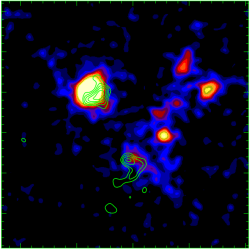Just as humans develop and grow the fastest when we are young, it also appears our universe grew and developed stars at an incredibly fast rate when it was young, too. New measurements from some of the most distant galaxies helps support evidence that the strongest burst of star formation in the history of the universe occurred about two billion years after the Big Bang. An international team of astronomers from the UK, France, Germany and the USA have found evidence for a dramatic surge in star birth in a newly discovered population of massive galaxies. The astronomers have been studying five specific galaxies that are forming stars at an incredible rate. The galaxies also have large reservoirs of gas to power star formation for hundreds of millions of years. These galaxies are so distant that the light we detect from them has been travelling for more than 10 billion years, meaning we see them as they were about a three billion years after the Big Bang.
The recent discovery of a new type of extremely luminous galaxy during this early epoch of the universe - one that is very faint in visible light, but much brighter at longer, radio wavelengths - is the key to the new results. Using a new and much more sensitive camera that detects radiation emitted at sub-millimeter wavelengths (longer than the wavelengths of visible light that we see with but somewhat shorter than radio waves), astronomers first found this type of galaxy in 1997. In 2004 a group of astronomers proposed that these distant "submillimetre-galaxies" might only represent half of the picture of rapid star formation in the early Universe. They suggested that a population of similar galaxies with slightly hotter temperatures could exist but have gone largely unnoticed.
The team of scientists searched for the missing galaxies using observatories around the world: the MERLIN array in the UK, the Very Large Array (VLA) in the US (both radio observatories), the Keck optical telescope on Hawaii and the Plateau de Bure submillimetre observatory in France. The instruments found and pinpointed the galaxies, measured their distances and then confirmed their star-forming nature through the detection of the vastly extended gas and dust.
Click here for more images and a movie of the Sub-millimeter Star Forming Galaxies.
The new galaxies have extremely high rates of star formation, far higher than anything seen in the present-day universe. They probably developed after the first stars and galaxies had already formed in what would have been a perfectly smooth Universe. Studying these new objects gives astronomers an insight into the earliest epochs of star formation after the Big Bang.
This information was presented by Dr. Scott Chapman from the Institute of Astronomy in Cambridge at the Royal Astronomy Society's National Astronomy Meeting on April 1, 2008. Chapman's work is supported by a parallel study made by PhD student Caitlin Casey.
Original News Source:
Royal Astronomy Society Press Release
 Universe Today
Universe Today
